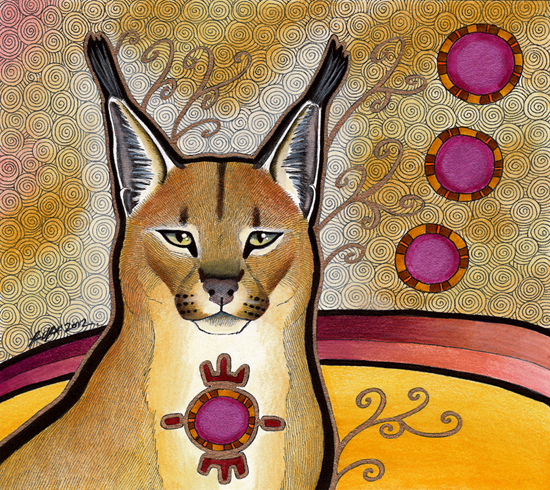Caracal – Leap! 
Keywords:
Leap! Investigation. Keeping yourself to yourself. Aim high. An ability to change directions seamlessly. Changing your mind. Adapting effortlessly. Efficiency. Effective in business matters. A connection to royalty and grandeur. Desert magic. Savannah magic. Perfect timing. Secrecy.
DESCRIPTION
The Caracal (Caracal caracal), also known as the desert lynx and the Persian lynx is an obligate carnivore wild cat found in Africa, Central Asia, the Middle East, and parts of Pakistan and India. They prefer to live in dry areas like savannas, semideserts, scrub forests etc. but will also live in forests and marshy lowlands. It is less active when the temperature goes above 20 Celsius. They are nocturnal, and not much is known about them as they prefer to avoid humans, and are secretive in nature.
It is a stocky, medium-sized cat with characteristically long tufted ears (which often cause it to be mistaken for a lynx), hind legs longer than the forelegs, with females being smaller than males. They are known for their ability to leap higher than 4 metres, catching birds in mid-air after stalking or ambushing them. They are powerful, efficient hunters, able to catch and kill prey up to three times their size. They are also excellent climbers. They eat small mammals (like duikers, young antelopes etc.), birds, rodents and reptiles. They will only take livestock when their wild prey is scarce. They may have to compete with foxes, wolves, leopards and hyena for prey.
Caracals are territorial, and tend to live alone, or in pairs. They are sexually mature at one year old. They breed throughout the year, and have litters of one to six kittens. Female kittens stay with their mothers longer. They can live as long as 16 years in captivity.
Caracals are more easily tamed than some of the other wild cats, and have even been tamed in coursing and hunting in India, Persia and Egypt, especially among royalty. Caracals were sometimes placed in arenas with flocks of pigeons, which created the expression: ‘To put the cat among the pigeons.’ They have been spiritually significant in ancient Egyptian culture, where it has appeared in art and sculptures, and been embalmed. Their coats have also been valued for clothing and mats. In some regions it is killed when seen near livestock, and is poached for the pet trade.
Was this helpful?
0 / 0